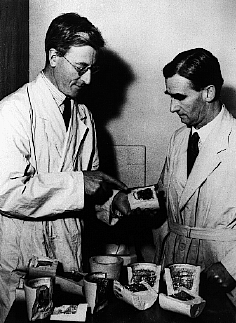




When Hartung opened up his first satisfactory crucible of glass he rang me at home at midnight. Working hours didn't seem to worry anybody. - Sir Lawrence Hartnett (1)
Ernst Johannes Hartung was Professor of Chemistry at the University of Melbourne, and was an enthusiastic and dedicated chemist. He was Chairman of the Advisory Committee on Optical Materials, a sub-section of the Optical
Munitions Panel in charge of figuring out how to produce optical
glass in Australia. His contribution towards the success of the Panel was invaluable. (Shown here: E.J. Hartung (L) with Mr Ampt (R))
In 1940, T.H. Laby asked Hartung if he could make optical glass; he replied, 'I don't see any reason why not. It is a
very big place and we ought to get sufficiently pure sand.
(2)
Hartung then travelled to Sydney to hold initial discussions with the technical staff of Australian Consolidated Industries (ACI). In his first report to the Panel (September 1940). Hartung wrote :
This indeed was the case. Hartung and ACI worked in conjunction to produce the first optical glass in Australia, and Hartung presented the Panel with the first-ever sample of Australian-made optical glass in December 1940. On 21 September 1941, ACI 'produced the first large-scale batch of optical glass ever made in Australia'.(4) - a truly remarkable achievement!
Hartung also built a small experimental, gas-fired furnace in his laboratory at the University of Melbourne. He used this to undertake valuable
optical glass experiments, including the testing of different refractory clays and raw materials.
Another of Hartung's interests was astronomy. After the war, he established an observatory at his home in Mount Macedon, Victoria. He also wrote a book on the southern skies for observers. Hartung retired in 1953. After his death in 1979, his 12 inch telescope and observation hut were relocated to the roof of the Physics Department at Monash University.
I visited Sydney from August 26th - 28th last ... I was very much
impressed by the keenness and enthusiasm of staff and operatives alike,
coupled also with a lively appreciation of the difficulties of the
problem ... I am glad to be able to state that as the result of our
discussions, and a careful analysis of available data, preliminary work
is now in full swing at the glass works in Sydney, and also in the
Chemistry Department of the University of Melbourne. Close co-operation
on the problem will take place in the future between these
institutions.(3)
(1)
Sir Laurence Hartnett (1985), 'Recollections of the Optical
Munitions Panel in Australia', Australian Physicist, vol. 22, May, pp. 158-60; with notes by H.C. Bolton, p. 159.
(2)
E.J. Hartung (1940), Tape Recording of Reminiscences, University of Melbourne Archives.
(3)
J.S. Rogers, The History of the Optical Munitions Panel: July 1940 - December 1946, Australian Archives, Brighton, Melbourne, MP 730/11, Box 3, p. 47.
(4)
D.P. Mellor (1958), 'Optical Munitions', Australia in the War of 1939-1945: The Role of Science and Industry, ch. 12, series 4: civil, vol. 5, Australian War Memorial, Canberra, p. 257.








Published by the Australian
Science Archives Project on
ASAPWeb, 30 April 1997
Comments or corrections to:
Bright Sparcs (bsparcs@asap.unimelb.edu.au)
Prepared by: Denise Sutherland
and Elissa Tenkate
Updated by: Joanne Evans
Date modified: 4 January 1998
 Top |
Bright SPARCS |
ASAPWeb
Top |
Bright SPARCS |
ASAPWeb
